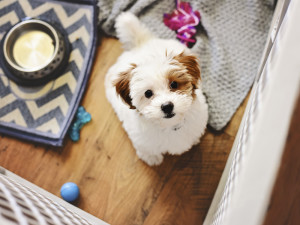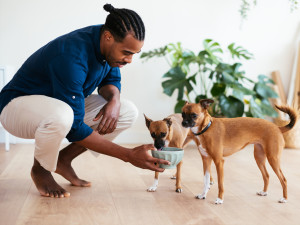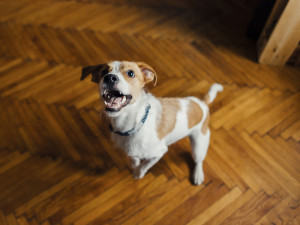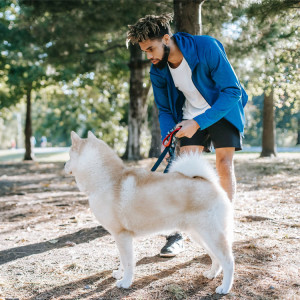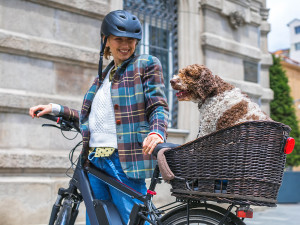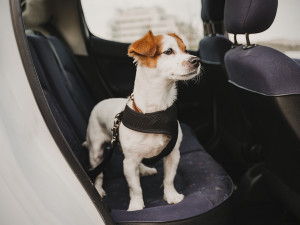How to Crate Train a Puppy
Effective techniques to crate train your dog with ease

Share Article
If you’re gearing up to bring home a new dog, chances are ‘buy a crate’ is on your to-do list (right in between ‘choose a pet food’ and ‘secure an Instagram handle with my dog’s name’). You’re probably wondering whether you should crate train your dog, too. A lot of trainers and veterinarians recommend crates for potty training dogs for a variety of reasons. To get the inside scoop on why you should consider crate training – and how to do it – we checked in with board-certified veterinary behaviourist Dr Valli Parthasarathy from Synergy Behavior Solutionsopens in a new tab.
What is crate training, and why is it beneficial for dogs?
Crate training, like using pens and baby gates, is a form of confinement trainingopens in a new tab. The ability to keep your dog confined to a small area can come in handy throughout their life. With puppies, crate training can help with housebreaking and managing access to objects they are tempted to chewopens in a new tab (which is most things). But a crate’s usefulness extends beyond those early puppy years.

littleKin™ is Kinship’s home just for puppy and kitten parents. Bop over to check out expert advice, new pet tools, and special deals—all curated for your newest family member.
opens in a new tab“Crate trainingopens in a new tab can be important if your dog is recovering from injury or illness and needs to be kept calm and relatively inactive,” Dr Valli Parthasarathy says. “Being comfortable in a crate can also help reduce anxiety when your dog is at the veterinary clinic awaiting treatment.” Also, if you have your heart set on your pup becoming your favourite travel buddy, they’ll need to be acclimated to a crate for plane rides and hotel stays. There are even crash-tested crates and carriers that keep dogs safe on road tripsopens in a new tab. Crate training aside, dogs like to have a safe, quiet place to retreat to when they feel overwhelmed and need time to themselves. Relatable? Very.
What type of crate should I choose for my dog?
The type of crate you choose for your dog depends on how much you want to spend, if your dog is a chewer and what you want to use the crate for. Regardless, pick a crate that’s safe for your dog, appropriate for their weight and size and one that’s easy to take apart when you travel.
Plastic dog crates are good in the house and for travel – in the caropens in a new tab or on a plane. They’re also super easy to clean.
Metal dog crates are good for dogs who tend to chew a lot. They’re super sturdy and offer great visibility and ventilation.
Wooden crates are generally more attractive – they can even integrate into your furniture as an end table. They tend to be heavier and harder to clean.
Fabric dog crates are a cheaper option if you have a small breed dog who isn’t a chewer. It can also act as a travel carrier – but they’re not easy to clean.
When should you start crate training a puppy?
According to Dr Valli, crate training can start as soon as you bring your puppy home. In fact, there’s a chance the rescue centre that you got your pup from already started the process – so you may get lucky and have a head start. As mentioned, you’ll want to use a slow and steady approach when crate training. But even as you gradually increase your puppy’s time in the crate, understand that young dogs need frequent loo breaks. So, they shouldn’t stay in their crate for too long, even if they feel generally comfortable.
Dr Valli has a go-to formula for how many hours a puppy can go between bathroom breaks. “My rule of thumb is to take the puppy’s age in months and add one,” she says. “So, a two-month-old puppy needs a potty break every three hours. But that doesn’t mean they should go right back in the crate after they potty. Puppies need plenty of time outside the crate to playopens in a new tab, exerciseopens in a new tab, socialise, and learn to be good doggos.” Four hours should be the max that a puppy is crated, unless it’s overnight.
Can I use the crate for potty training my puppy?
Yes, a crate can be a helpful tool for housebreaking your puppy: because dogs are generally clean animals, they don’t like to go to the loo where they lie down and sleep. Just make sure the crate is the right size, so your dog can lie down, stand up and turn around. When your dog has to go out, they will usually whine or scratch to let you know.
How do I introduce the crate to my dog?
Follow these steps to crate train your puppy or dog:
1. Get a crate (obviously)
There are many different options available. Look for one big enough to accommodate your fully grown dog. When your puppy is small, you can block off part of the space. If they have too much room, they may decide that the far end of the crate is a good place to wee.
2. Make it comfy
Put a soft blanket or towel in the crate and keep it in an area where you spend a lot of time (you can eventually relocate the crate once they feel comfortable).
3. Introduce your puppy to the crate
Show your dog the crate and let them explore it inside and out. Toss treatsopens in a new tab or toys inside to entice them to enter. Give them a few days to get used to the presence of the crate.
4. Create a positive association
Start feeding your pup their meals in the crate (because is there anything a dog loves more than dinner time?). Begin by leaving the door open while they eat, then try closing it. At first, let them out as soon as they finish. Then try leaving them in there for a few extra minutes. Praise them and offer treats whenever they go into the crate on their own.
5. Increase time spent in the crate
Come up with a verbal or visual command that you’ll use to direct them to the crate. When your dog enters, give them the command so they associate it with the desired behaviour. Close the door and stay near them for a few minutes. As your dog gets used to the crate, gradually leave them in it for longer periods while you’re at home. You want to be able to check on them so you know they’re comfortable being confined before leaving them alone.
6. Crate your dog when you’re gone
Once you’re sure your puppy is safe and calm in the crate, start leaving them in there for short periods while you’re out of the house, then slowly increase the length of time you’re gone.
How do I get my dog to enter the crate willingly?
There are a few tricks to get your dog to willingly enter the crate:
When you call your dog over to the crate, give them a treat. You can also give them a voice cue like ‘crate’ and motion inside the crate with a treat in your hand.
Practice praising your dog after they enter the crate, then close the door and sit quietly near it for up to ten minutes. Leave the room, then return and let them out.
Repeat this process a few times a day, gradually increasing the length of time you leave them in the crate and the amount time you’re out of sight.
How do I prevent my dog from whining or barking in the crate?
It’s gut-wrenching to hear your pup whining in their crate. Even worse? Ignoring their cries and leaving them to suffer not-so-silently. But the thing is, there’s a good chance they’re not suffering. They may just want your attention, and the fact that it’s 3am on a Tuesday means less than nothing to them. So, try waiting it out for a few minutes. Many times, they’ll stop when they realise they aren’t going to get what they want.
If the whining persists and you suspect your puppy needs a bathroom break, let them out of the crate and take them outside. This should be a potty-only mission. No playing, no meandering, no sniffing – just a quick wee break before going right back into the crate. It’s important not to give in to their demands for attention every time they whine or crate training will be a long, painful process. There is plenty of time for them to wrap you around their paw. Today is not that day.
How do you crate train an adult dog?
No secret sauce here. The approach for crate training an older dog is similar to puppies, but you may need to take things even slower because it takes a shorter amount of time to crate train a puppy.
“An older dog who has never been confined can become anxious or scared if suddenly closed in a crate,” Dr Valli says. “So, at first, remove the door or keep it propped open. Then, give your dog treats when they voluntarily go into the crate. Eventually, you can close the door and very slowly increase the time that you keep them inside. For adult dogs, I don’t recommend leaving them in a crate for more than four hours at a time, again, unless they’re sleeping at night.”
Some things just weren’t meant to be
Crate training can be very beneficial, but Dr Valli cautions that it’s not the right choice for every dog. “I usually won’t recommend crates for confinement with a dog who has panicked in a crate in the past (such as biting the bars, breaking out, injuring themselves, throwing themselves against the crate walls) or a dog who has separation anxiety. Instead, there are other ways that these dogs may learn to tolerate confinement, including being in a larger pen or baby-gated in a room.” If you’re having trouble crate or potty training your pup, we recommend hiring a professional dog traineropens in a new tab to help.
Frequently asked questions
My dog seems scared of the crate. What should I do?
If your dog seems fearful, use a counter-conditioning technique, with which you help them change their association with the crate from negative to positive.
Should I leave my dog in the crate for extended periods?
Puppies under six months shouldn’t stay in a crate for more than three to four hours. An adult dog shouldn’t ever stay in the crate too long because they can become anxious.
Can I use the crate as punishment for my dog?
Never punish your dog. Your dog should never associate the crate with anything negative, especially fear. Read here for more advice on positive reinforcement training.
Is crate training suitable for all dogs?
For most dogs, crate training is a good option, but if your dog already has anxiety or gets anxiety in their crate, you may want to consider other options.
References

Kate Sheofsky
Kate Sheofsky hails from San Francisco, where she developed a love of writing, Giants baseball, and houses she can’t afford. She currently lives in Portland, OR, and works as a freelance writer and content strategist. When not typing away on her laptop, she enjoys tooling around the city with her two rescue pups searching for tasty food and sunny patios.
Related articles
![Shy black dog walking with owner at the park.]() opens in a new tab
opens in a new tabHow to Help an Anxious Dog Conquer Their Fears
Six animal behaviourists share pro tips for boosting the confidence of a fearful dog
![Dog walker crossing a street with three dogs]() opens in a new tab
opens in a new tabHow to Prepare Your Pup For Daycare and Dog Walkers
Set your pup up for success
![Three dogs biting a stick.]() opens in a new tab
opens in a new tabSome Like It Rough: Playing vs Fighting
Two animal behaviour experts agree that it’s usually play fighting. Here’s how you can tell
![A young woman standing next to her bike with the dog in the basket]() opens in a new tab
opens in a new tabHow to Take Your Dog on a Bike Ride
So they can feel the wind in their fur
![Jack Russell dog in backseat of s car wearing a safety harness and seat belt]() opens in a new tab
opens in a new tabHow to Keep Your Dog Safe in the Car
Hitting the road with your dog? Make sure they’re safe with this helpful advice
![3 Screenshots side by side of cover photos for three different Veterinarians who post videos on Tik Tok.]() opens in a new tab
opens in a new tab11 Vets You Should Follow on TikTok
TikTok has a ton of veterinarians giving helpful (and entertaining) advice
